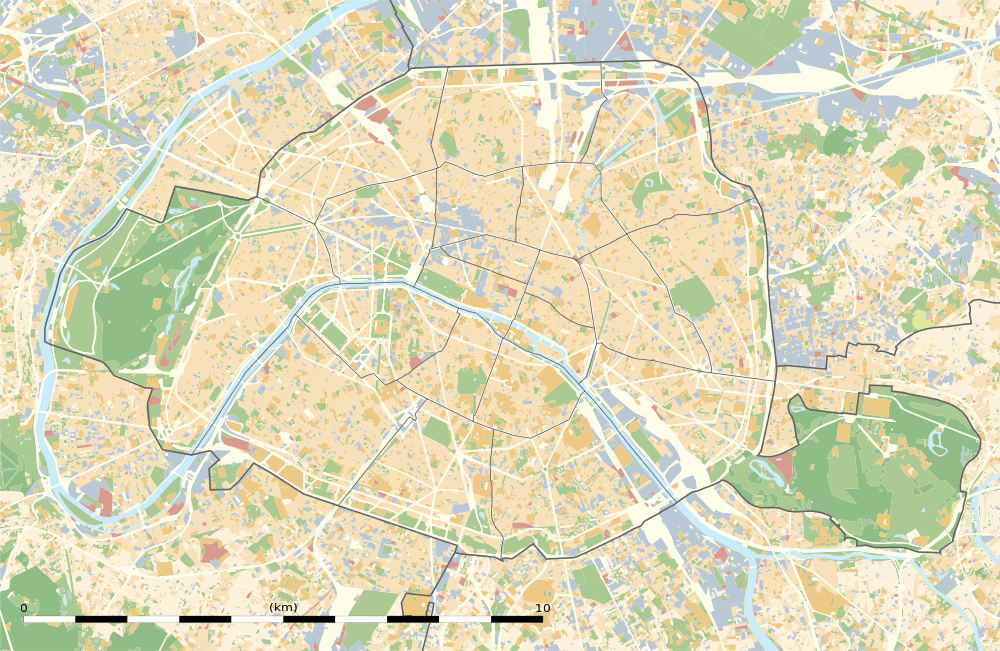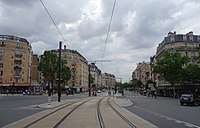Boulevard Soult
The Boulevard Soult is a boulevard in the Bel-Air neighborhood in the 12th arrondissement of Paris, France. It is one of the Boulevards of the Marshals that run in the outer parts of the city.
The boulevard Soult at Porte de Montempoivre | |
 Shown within Paris | |
| Length | 1,270 m (4,170 ft) |
|---|---|
| Width | 40 m (130 ft) to 43.4 m (142 ft) |
| Arrondissement | 12th |
| Quarter | Bel-Air |
| Coordinates | 48°50′29″N 2°24′34″E |
| From | 279, boulevard Poniatowski Avenue Daumesnil |
| To | Boulevard Davout 116 bis, cours de Vincennes |
| Construction | |
| Denomination | March 2, 1864 |
Description
The boulevard Soult runs from avenue Daumesnil at Porte Dorée to Porte de Vincennes, where it is continued by boulevard Davout.
Boulevard Soult was accessible through the Petite Ceinture bus line. It can now be reached through the tramway Line 3 (Porte de Vincennes, Alexandra David-Néel, Montempoivre, Porte Dorée stations), the Métro Line 1 (Porte Dorée station), as well as RATP bus lines 29, 46, 56, 86 and 351.
History
In 1859, the military engineering service handed operation of the boulevard to the Paris city council under conditions.[1] Boulevard Soult is part of the Boulevards of the Marshals belt first established in 1861 along the Thiers wall as a replacement for Rue Militaire.
In 1864, the boulevard was named after Jean-de-Dieu Soult (1769–1851), 1st Duke of Dalmatia and Marshal of France.[2]
In the 1930s, HBM-type social housings where built at La Zone to accommodate working-class people that have come through rural flight after WW1. These buildings stretch along a large part of the boulevard, on the outer side between Porte Dorée and Porte de Vincennes. On September 22, 2008, a fire killed a resident and devastated a building at No. 64 boulevard Soult at Porte de Saint-Mandé.[3]
Since December 2012, a new section of the tramway Line 3 has been running on boulevard Soult.
Notable buildings and landmarks
- At no. 27, there was a 16-meter-high and 2.20-meter-circumferential European nettle tree planted in 1906 and classified as a "remarkable tree".[4] This tree no longer exists.[5]
- In the mid-1960s, the southeastern section of boulevard Soult was altered to enable the construction of the lycée Paul Valéry, inaugurated in 1962 at No. 38.
- Square Émile-Cohl and square Georges-Méliès
- Access to the Promenade plantée at the level of rue du Sahel
- No. 101 : Access to Sentier des Merisiers, one of the narrowest streets of Paris, that leads to rue du Niger
Square Émile-Cohl The Montempoivre station of tramway Line 3 
Tramway line .jpg)
Toward Porte de Vincennes
References
- Adolphe Alphan (ed.); Deville, Adrien; Hochereau, Émile (1886). "Décision du 28 juillet 1859". Ville de Paris : recueil des lettres patentes, ordonnances royales, décrets et arrêtés préfectoraux concernant les voies publiques (in French). Paris: Imprimerie nouvelle (association ouvrière). pp. 314–315.CS1 maint: extra text: authors list (link)
- Jacques Hillairet. Dictionnaire historique des rues de Paris (in French). Paris: Les Éditions de Minuit. p. 529. ISBN 2-7073-1054-9. OCLC 466966117.
- "Un mort dans un incendie à Paris". Le Figaro (in French). September 22, 2008.
- "Les arbres remarquables". paris.fr (in French). Archived from the original on 2013-04-03.
- "La triste fin du micocoulier remarquable du boulevard Soult". belairsud.blogspirit.com (in French). June 29, 2015. Retrieved February 7, 2019.